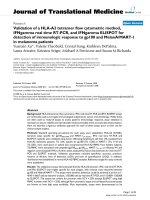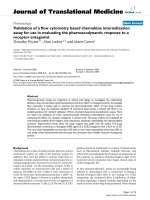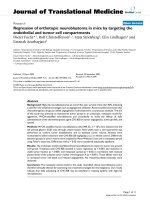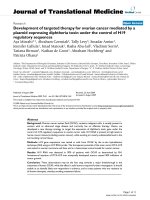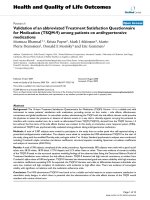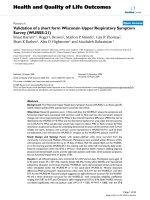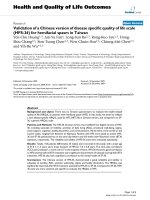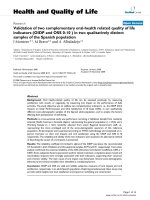Báo cáo hóa học: "Validation of the nausea and vomiting of pregnancy specific health related quality of life questionnaire" pot
Bạn đang xem bản rút gọn của tài liệu. Xem và tải ngay bản đầy đủ của tài liệu tại đây (285.59 KB, 6 trang )
BioMed Central
Page 1 of 6
(page number not for citation purposes)
Health and Quality of Life Outcomes
Open Access
Research
Validation of the nausea and vomiting of pregnancy specific health
related quality of life questionnaire
Anaïs Lacasse
1,2
and Anick Bérard*
1,2
Address:
1
Faculty of Pharmacy, University of Montreal, Montreal, Quebec, Canada and
2
Research Center, CHU Sainte-Justine, Montreal, Quebec,
Canada
Email: Anaïs Lacasse - ; Anick Bérard* -
* Corresponding author
Abstract
Background: The only existing NVP-specific quality of life (QOL) questionnaire is the "Health-
Related Quality of Life for Nausea and Vomiting during Pregnancy" (NVPQOL). However, the
reliability and validity of the NVPQOL have never been established. In order to justify its usage, the
internal consistency and criterion validity of the NVPQOL questionnaire must be ascertained.
Methods: A prospective observational study including pregnant women attending CHU Sainte-
Justine or René-Laennec clinics for their prenatal care was conducted from 2004 to 2006. Women
were eligible if they were ≥ 18 years of age and ≤ 16 weeks of gestation at the time of their first
prenatal visit. During this initial visit, women who reported NVP were also asked to complete the
NVPQOL and the SF-12. Cronbach's alpha coefficients were calculated as the measures of the
internal consistency of the NVPQOL. With respect to the criterion validity, linear regression
models were built to measure the association between the NVPQOL and the SF-12 scores.
Results: Of the 367 women included in the study, 288 (78.5%) reported NVP in the first trimester
of pregnancy. Among these women, the Cronbach's alpha coefficients were high for the complete
NVPQOL questionnaire (α = 0.98), and for the four distinct domains [physical symptoms and
aggravating factors (α = 0.90); fatigue (α = 0.94); emotions (α = 0.86); limitations (α = 0.97)]. NVP-
specific QOL as measured by the NVPQOL was significantly associated with physical and mental
QOL as measured by the SF-12.
Conclusion: Our data suggest that the NVPQOL is a reliable and valid index to measure NVP-
specific QOL in the first trimester of pregnancy.
Background
Most pregnant women (50 to 90%) experience nausea
and vomiting of pregnancy (NVP) during the first trimes-
ter [1]. NVP appears normally between the 4
th
and 6
th
week of gestation and peaks between week 8 and 12 [2,3].
Most of the symptoms disappear by the 20
th
week of ges-
tation [2]. A more severe form of NVP, called hyperemesis
gravidarum (HG), can also occur in 0.5 to 3% of pregnan-
cies [4,5], and has been found to be the most common
reason for hospitalisation during the first trimester of
pregnancy [6].
NVP can have a significant impact on family life, on the
ability to perform usual daily activities, on social func-
Published: 9 May 2008
Health and Quality of Life Outcomes 2008, 6:32 doi:10.1186/1477-7525-6-32
Received: 24 August 2007
Accepted: 9 May 2008
This article is available from: />© 2008 Lacasse and Bérard; licensee BioMed Central Ltd.
This is an Open Access article distributed under the terms of the Creative Commons Attribution License ( />),
which permits unrestricted use, distribution, and reproduction in any medium, provided the original work is properly cited.
Health and Quality of Life Outcomes 2008, 6:32 />Page 2 of 6
(page number not for citation purposes)
tioning [7], and on stress levels [8]. In addition, the pres-
ence and severity of NVP have been shown to have an
impact on the quality of life (QOL) of pregnant women
[9-11]. Since health-related QOL is a non-negligible out-
come when evaluating the burden of illness of health
problems, it is important to have a valid way of measuring
this health issue. Some generic measures of health-related
QOL are available, but the only existing NVP-specific
QOL questionnaire is the "Health-Related Quality of Life
for Nausea and Vomiting during Pregnancy" (NVPQOL)
[12]. However, the reliability and criterion validity of the
NVPQOL have never been established.
To improve confidence in using the NVPQOL, we aimed
to measure the internal consistency of the NVPQOL ques-
tionnaire. In addition, we sought to establish the criterion
validity of the NVPQOL questionnaire by measuring the
extent to which it is associated with the generic QOL-SF-
12.
Methods
A prospective observational study on pregnant women
having prenatal care at the obstetrics and gynaecology
clinic of either the Centre Hospitalier Universitaire Sainte-
Justine (CHU Sainte-Justine) or the René-Laennec clinic,
both affiliated with the University of Montreal, Quebec,
Canada was conducted from October 2004 to March
2006. Women were eligible if they were: 1) at least 18
years of age; 2) at their first prenatal visit at the obstetric
and gynaecology clinic of the CHU Sainte-Justine or the
René-Laennec clinic; 3) pregnant within 16 weeks of the
first day of their last menses; 4) able to read and under-
stand either French or English; and 5) provided written
consent. Ethics approval was obtained from the CHU
Sainte-Justine ethics committee.
The present study's design and data collection were previ-
ously described elsewhere[13]. However, for ease of
understanding, the study methodology is summarized. At
the end of their first prenatal visit, eligible women who
accepted to participate were asked to complete a self-
administered questionnaire at home. Data on demo-
graphic and socio-economic variables, NVP status and
generic QOL were collected. Only women who reported
suffering from NVP were asked to complete the NVPQOL
questionnaire. This present validation study was done in
the subgroup of pregnant women who reported suffering
from NVP in the self-administered questionnaire.
The NVPQOL
The NVPQOL questionnaire measures QOL in the last
week and contains 30 items covering 4 general domains:
physical symptoms and aggravating factors, fatigue, emo-
tions, and limitations [12] (Table 1). Each item of the
NVPQOL is measured using a Likert 7-point scale ranging
from 1 (none of the time) to 7 (all of the time). The total
NVPQOL score can be obtained by summing the 30 items
(20
th
item reversed) and ranges between 30 and 210.
Lower scores correspond to better QOL.
The NVPQOL has been developed using established pro-
cedures for the development of health-related QOL ques-
tionnaires that have been used for a wide array of medical
conditions [12]. In addition, evidence of the content
validity of the NVPQOL is available [12]. Content validity
can be defined as the degree to which the sampling of
items in the questionnaire reflects the concept being
measured [14]. In fact, four sources of information have
been used to generate the NVPQOL items in the initial
development of the questionnaire: focus groups of
women suffering from NVP, MEDLINE search, judgment
from experts and clinicians, and a review of other vali-
dated health questionnaires. Moreover, factor analysis sta-
tistical procedures where use for the development of the
NVPQOL, which also provides additional evidence to the
content validity of the index [12].
Generic quality of life
For comparison purposes, the generic health-related QOL
was measured with the standard version (past 4 weeks)
12-item Short-Form Health Survey v.1 (SF-12) [15]. This
shorter version of the commonly used SF-36 yields two
summary measures: the physical component summary
scale (PCS) and the mental component summary scale
(MCS)[16]. Summary measures range from 0 to 100 and
are calculated using the scores of the twelve items; higher
scores represent better QOL. PCS and MCS scores were
calculated with standard (United States) scoring algo-
rithms and normalised using the US general population
(mean, 50; SD, 10). The psychometric properties of the
SF-12 questionnaire have been extensively evaluated in
many different populations [15,17-19]. In fact, the SF-12
is highly reliable (test-retest correlations PCS = 0.86–0.89;
MCS = 0.76–0.77)[15,20] and has shown a very good cri-
terion validity as compared to the gold standard of health-
related QOL, the SF-36 (PCS = 0.90–0.96; MCS = 0.93–
0.97) [15,19].
NVP severity
The severity of NVP was measured by the modified Preg-
nancy-Unique Quantification of Emesis and Nausea
(modified-PUQE) [13]. This index is validated and meas-
ures NVP severity during a pregnancy's first trimester. The
modified-PUQE is based on 3 physical symptoms of NVP:
the extent of nausea in hours, the quantity of retching epi-
sodes, and the number of vomiting episodes on an aver-
age day since the beginning of the pregnancy. Total scores
range between 3 and 15. When validated, the modified-
PUQE was significantly associated with an outcome of
direct importance for women who experience NVP such as
Health and Quality of Life Outcomes 2008, 6:32 />Page 3 of 6
(page number not for citation purposes)
QOL (SF-12 PCS: p < 0.0001; SF-12 MCS: p = 0.0008).
Moreover, a substantial concordance was found between
the modified-PUQE and the frequently used Motherisk
PUQE. (ICC = 0.71) [13].
Statistical analysis
Descriptive statistics were used to estimate the distribu-
tion of maternal characteristics and health-related QOL
scores in the study population. Internal consistency,
defined as the intercorrelations among items of a scale
[21], was measured using Cronbach's alpha coefficients
(α) for the complete NVPQOL questionnaire, and for
each distinct domain. Cronbach's coefficients range
between 0 (weak reliability) and 1 (perfect reliability). We
considered the 0.7 cut-off as indicating acceptable internal
consistency for research purposes. An α ≥ 0.9 shows excel-
lent internal consistency and high reliability [14,21]. Sec-
ondly, criterion validity can be assessed by the extent to
which a measure is able to predict the results of a gold
standard [14]. Therefore, NVPQOL was compared to the
SF-12. Linear regression models were built to measure the
association between the NVPQOL score and the two SF-12
summary measures. Finally, linear regression models were
built to measure the association between the NVPQOL
score and the severity of NVP, a clinically relevant out-
come. Significance was assumed at p < 0.05. All statistical
analyses were performed using SAS Version 9.1 (SAS Insti-
tute, NC, USA).
Results
A total of 367 pregnant women met all inclusion criteria,
out of which, 288 reported NVP during the 1
st
trimester
(78.5%). Those who reported NVP in the 1
st
trimester
formed the study population.
Maternal characteristics including demographics, NVP
severity, and health related QOL are presented in Table 2.
The mean age of the participants was 32 (SD: 4.6) years
while the mean gestational age at recruitment was 11 (SD:
1.8) weeks. Eighty-two percent of participants were Cau-
casian. As for QOL, the mean NVPQOL score was 94.8
(SD: 39.8). The mean physical component score on the
SF-12 was 42.8 (SD: 9.1); the mean mental component
score on the SF-12 was 45.9 (SD: 8.4).
Table 1: Domains and items of the NVPQOL questionnaire.
Domains 30-Items
Physical symptoms and aggravating factors Nausea
Sick to your stomach
Vomiting
Dry-heaves
Poor appetite
Symptoms worse in evening
Not eaten for longer than you would like
Worse when exposed to certain smells
Worse when exposed to certain foods
Fatigue Fatigue
Worn-out, lack of energy
Exhausted
Tired
Emotions Emotional
Less interested in sex
Downhearted, blue, sad, unhappy, depressed, gloomy
Frustrated
Fed up with being sick
Reassured that your symptoms are part of normal pregnancy
Can't enjoy your pregnancy
Limitations Everything is an effort
Accomplished less than you would like
Took longer to get things done than usual
Difficult or took extra effort to perform, and/or limited in types of work and other activities
Difficulty maintaining your normal social activities with family, friends, neighbours, or social groups
Rely on your partner to do things that you would normally do for family
Difficulty looking after home
Difficulty shopping for food
Difficulty preparing or cooking meals
Cut down on amount of time you spent at work or other activities
Source: Magee et al. 2002, with permission.
Health and Quality of Life Outcomes 2008, 6:32 />Page 4 of 6
(page number not for citation purposes)
Reliability of the NVPQOL
Reliability of the NVPQOL was supported via internal
consistency with Cronbach's alpha being larger than 0.8
for the whole questionnaire (α = 0.98) and for the 4 dis-
tinct domains respectively (Table 3).
Validity of the NVPQOL
When comparing NVPQOL and SF-12 QOL scores, lower
NVP-specific QOL (higher NVPQOL score) was signifi-
cantly associated with a lower QOL as measured by the SF-
12 (PCS and MCS p < 0.0001; Figure 1 and 2)
NVPQOL and NVP severity
When the NVPQOL and NVP severity scores were com-
pared, NVP-specific QOL was significantly associated with
more severe NVP symptoms as measured by the modified-
PUQE (p < 0.0001).
Discussion
Our study established internal consistency and criterion
validity of the only existing NVP-specific QOL question-
naire. Reliability of the NVPQOL was supported by inter-
nal consistency for the complete questionnaire and the 4
distinct domains, respectively. We found a significant
association between the NVPQOL score and the SF-12
physical and mental scores. The NVPQOL score was also
correlated with severity of NVP symptoms.
Almost all estimated coefficients of internal consistency
for the NVPQOL showed excellent reliability. In spite of
the fact that the coefficient for the emotion domain was
not above the 0.9 threshold, it showed acceptable internal
consistency [14,21]. Although the test-retest reliability of
the NVPQOL could not be measured within our study, the
higher the internal consistency, the higher will be the test-
retest reliability in theory [14]. As stated earlier, content
validity of the NVPQOL has already been established [14].
The fact that this study showed an association between the
NVPQOL and SF-12 scores is an argument towards its cri-
terion validity since the SF-12 is a gold standard in terms
of health-related QOL. Furthermore, the NVPQOL score
correlated well with the NVP severity, which enhances the
face validity of the NVPQOL given that QOL was found to
be significantly associated with the NVP severity in the lit-
erature [11].
Table 3: Cronbach's alphas for the NVPQOL questionnaire.
Scale α
Whole questionnaire 0.98
Physical symptoms and aggravation factors domain 0.90
Fatigue domain 0.94
Emotion domain 0.86
Limitations domain 0.97
Table 2: Demographics of women suffering from NVP.
Characteristics (n = 288) Measure
Maternal age – yr (mean ± SD) 31.65 ± 4.62
Gestational age – wk (mean ± SD) 11.00 ± 1.75
Country of birth – n (%)
Canada 189 (65.63)
Other 99 (34.38)
Race – n (%)
Caucasian 237 (82.29)
Asian 9 (3.13)
Black 26 (9.03)
Hispanic 16 (5.56)
Rx insurance plan – n (%)
Provincial plan (RAMQ) only 81 (28.32)
Other insurance 205 (71.68)
Work status – n (%)
Student or not working 72 (25.09)
Working 215 (74.91)
Living arrangement – n (%)
With spouse or with someone (family or cotenant) 281 (97.91)
Living alone 6 (2.09)
Education level – n (%)
University completed 185 (64.46)
University not completed 102 (35.54)
Household income – CDN$/yr n (%)
Less than 40 000$ 88 (31.43)
Between 40 000 et 79 999$ 70 (25.00)
80 000 and over $ 122 (43.57)
Comorbidities before pregnancy * – n (%)
0 207 (71.88)
1 70 (24.31)
2 or 3 11 (3.82)
Gravidity – n (%)
Multigravida 240 (83.33)
Primigravida 48 (16.67)
Pre-pregnancy BMI – n (%)
Underweight or normal (BMI <25 kg/m
2
) 193 (68.68)
Overweight (25≤ BMI <30 kg/m
2
) 65 (23.13)
Obese (BMI ≥30 kg/m
2
) 23 (8.19)
NVP severity (mean ± SD)
PUQE score 6.69 ± 2.30
NVP-specific QOL (mean ± SD)
NVPQOL score 94.82 ± 39.84
Physical and mental QOL (mean ± SD)
PCS SF-12 score 42.84 ± 9.07
MCS SF-12 score 45.88 ± 8.38
* Including asthma, anemia, depression, hypothyroidism, diabetes,
epilepsy, hypertension and various problems like infections, eczema,
migraines, etc.
Health and Quality of Life Outcomes 2008, 6:32 />Page 5 of 6
(page number not for citation purposes)
Generic QOL questionnaires are often used in pregnancy
studies [22]. However, generic measures can be unrespon-
sive to changes in specific areas of health [23]. The only
validated pregnancy-related specific QOL questionnaire is
the Mother-Generated Index [24], which assesses a
mother's postnatal quality of life. As of now, no preg-
nancy-specific questionnaire allows for the evaluation of
QOL during the gestational period. Because NVP is a prev-
alent condition in pregnancy, the NVPQOL questionnaire
could be useful to perinatal epidemiological research. The
use of the NVPQOL is justified since specific measures of
QOL can enhance the detection of small, clinically impor-
tant aspects in QOL related to specific areas of interest
[12,23]. In fact, women suffering from NVP are likely to
have distinctive concerns such as fears about antiemetic
medication use during pregnancy [12]. Moreover, health-
related QOL can be a good measure reflecting service
needs and thus, it is useful to inform physicians [25]. For
this reason, an NVP-specific index such as the NVPQOL
could be a very useful tool in clinical practice in order to
provide optimal management for women in need.
In our study, the time windows for which the generic and
specific health-related QOL were measured were compa-
rable. The standard version of the SF-12 covered the past
4 weeks and the NVPQOL covered the past week. Given
that most of the NVP symptoms disappear by the 20
th
week of gestation [2], we have good reasons to believe that
the NVPQOL questionnaire could also be used for the sec-
ond trimester of pregnancy, starting at the 15
th
week of
gestation.
The NVPQOL questionnaire has been previously reported
to be suitable for all women with mild to severe NVP as
well as having a good external validity [12]. Our study
population is comparable to the Montreal population of
pregnant women. The majority of women in our study
cohort were Caucasians, which consequently improves
the external validity of our results to Canadian popula-
tion. Indeed, in 2001 less than 15% of the Canadian pop-
ulation belonged to a visible minority group [26].
Conclusion
In conclusion, we established the reliability and validity
of the only existing NVP-specific QOL questionnaire in a
cohort of 288 pregnant women reporting NVP in the first
trimester. Our results confirm that the NVPQOL is a relia-
ble and valid index to measure NVP-specific QOL and that
it is well suited for use during the first trimester of preg-
nancy. Globally, the NVPQOL can be a very useful tool in
health research and clinical practice.
Competing interests
The authors declare that they have no competing interests.
Authors' contributions
Each author has participated actively and sufficiently in
this study, and fulfils all authorship criteria of the Interna-
tional Committee of Medical Journal Editors. AL made
substantial contribution to acquisition of data, analysis
and interpretation of data, and drafting of the article. AB
made substantial contribution to conception and design
of the study, analysis and interpretation of data, and draft-
ing of the article. Each author revised critically the manu-
script and provided final approval of the version to be
published.
Acknowledgements
This study was supported by the Fonds de la Recherche en Santé du
Québec (FRSQ). Anaïs Lacasse is the recipient of a doctoral research bur-
sary from the Canadian Institutes of Health Research (CIHR). Dr. Anick
Bérard is the recipient of a career award from the CIHR/Health Research
Foundation, and is on the endowment Pharmaceutical Chair of the Famille
Louis-Boivin on 'Medications, Pregnancy and Lactation' at the Faculty of
Pharmacy of the University of Montreal and CHU Ste-Justine.
Association between NVPQOL score and physical QOL (SF-12, PCS)Figure 1
Association between NVPQOL score and physical
QOL (SF-12, PCS).
y = -0,1199x + 53,903 (p<.0001)
15
20
25
30
35
40
45
50
55
60
65
0 50 100 150 200
NVPQOL score
Physical QOL SF-12 score
Association between NVPQOL score and mental QOL (SF-12, MCS)Figure 2
Association between NVPQOL score and mental
QOL (SF-12, MCS).
y = -0,0867x + 53,516 (p<.0001)
15
25
35
45
55
65
0 50 100 150 200
NVPQOL score
Mental QOL SF-12 score
Publish with Bio Med Central and every
scientist can read your work free of charge
"BioMed Central will be the most significant development for
disseminating the results of biomedical research in our lifetime."
Sir Paul Nurse, Cancer Research UK
Your research papers will be:
available free of charge to the entire biomedical community
peer reviewed and published immediately upon acceptance
cited in PubMed and archived on PubMed Central
yours — you keep the copyright
Submit your manuscript here:
/>BioMedcentral
Health and Quality of Life Outcomes 2008, 6:32 />Page 6 of 6
(page number not for citation purposes)
We would like to thank the research nurses, for the recruitment of study
participants in the different clinics (Ms Marie Saint-Jacques, Ms Valérie
Tremblay and Ms Sophie Perreault).
References
1. Arsenault MY, Lane CA, MacKinnon CJ, Bartellas E, Cargill YM, Klein
MC, Martel MJ, Sprague AE, Wilson AK: The management of nau-
sea and vomiting of pregnancy. J Obstet Gynaecol Can 2002,
24:817-831.
2. Deuchar N: The psychological and social aspects of nausea
and vomiting of pregnancy. In Nausea and Vomiting of Pregnancy:
state of the art 2000. vol. 1. Edited by: Koren G and Bishai R. Toronto,
Motherisk; 2000:10-14.
3. Sherman PW, Flaxman SM: Nausea and vomiting of pregnancy in
an evolutionary perspective. Am J Obstet Gynecol 2002,
186:S190-S197.
4. Miller F: Nausea and vomiting in pregnancy: the problem of
perception is it really a disease? Am J Obstet Gynecol 2002,
186:S182-S183.
5. Bashiri A, Neumann L, Maymon E, Katz M: Hyperemesis gravi-
darum: epidemiologic features, complications and outcome.
Eur J Obstet Gynecol Reprod Biol 1995, 63:135-138.
6. Gazmararian JA, Petersen R, Jamieson DJ, Schild L, Adams MM, Desh-
pande AD, Franks AL: Hospitalizations during pregnancy
among managed care enrollees. Obstet Gynecol 2002,
100:94-100.
7. O'Brien B, Naber S: Nausea and vomiting during pregnancy:
effects on the quality of women's lives. Birth 1992, 19:138-143.
8. Kuo SH, Wang RH, Tseng HC, Jian SY, Chou FH: A comparison of
different severities of nausea and vomiting during pregnancy
relative to stress, social support, and maternal adaptation. J
Midwifery Womens Health 2007, 52:e1-e7.
9. Smith C, Crowther C, Beilby J, Dandeaux J: The impact of nausea
and vomiting on women: a burden of early pregnancy. Aust N
Z J Obstet Gynaecol 2000, 40:397-401.
10. Attard CL, Kohli MA, Coleman S, Bradley C, Hux M, Atanackovic G,
Torrance GW: The burden of illness of severe nausea and
vomiting of pregnancy in the United States. Am J Obstet Gynecol
2002, 186:S220-S227.
11. Kugahara T, Ohashi K: Characteristics of nausea and vomiting
in pregnant Japanese women. Nurs Health Sci 2006, 8:179-184.
12. Magee LA, Chandra K, Mazzotta P, Stewart D, Koren G, Guyatt GH:
Development of a health-related quality of life instrument
for nausea and vomiting of pregnancy. Am J Obstet Gynecol 2002,
186:S232-S238.
13. Lacasse A, Rey E, Ferreira E, Morin C, Berard A: Validity of a mod-
ified Pregnancy-Unique Quantification of Emesis and Nau-
sea (PUQE) scoring index to assess severity of nausea and
vomiting of pregnancy. Am J Obstet Gynecol 2008, 198:71-71.
14. McDowell I, Newell C: Measuring Health: A Guide to Rating Scales and
Questionnaires, 2nd edition 2nd edition edition. New York, Oxford
University Press; 1996-523.
15. Ware J Jr., Kosinski M, Keller SD: A 12-Item Short-Form Health
Survey: construction of scales and preliminary tests of relia-
bility and validity. Med Care 1996, 34:220-233.
16. Ware JEJ, Keller SD, Kosinski M: SF-12: How to score the Sf-12 Physical
and mental Health Summary scales. 2nd edition edition. Boston, The
Health Institute, New England Medical Center; 1995.
17. Larson CO: Use of the SF-12 instrument for measuring the
health of homeless persons. Health Serv Res 2002, 37:733-750.
18. Resnick B, Nahm ES: Reliability and validity testing of the
revised 12-item Short-Form Health Survey in older adults. J
Nurs Meas 2001, 9:151-161.
19. Gandek B, Ware JE, Aaronson NK, Apolone G, Bjorner JB, Brazier JE,
Bullinger M, Kaasa S, Leplege A, Prieto L, Sullivan M: Cross-valida-
tion of item selection and scoring for the SF-12 Health Sur-
vey in nine countries: results from the IQOLA Project.
International Quality of Life Assessment. J Clin Epidemiol 1998,
51:1171-1178.
20. Salek S: Compendium of quality of life instruments UK, John Wiley &
Sons; 1998.
21. Jensen MP: Questionnaire validation: a brief guide for readers
of the research literature. Clin J Pain 2003, 19:345-352.
22. Symon A: A review of mothers' prenatal and postnatal quality
of life. Health Qual Life Outcomes 2003, 1:38.
23. Guyatt GH, Feeny DH, Patrick DL: Measuring health-related
quality of life. Ann Intern Med 1993, 118:622-629.
24. Symon A, McGreavey J, Picken C: Postnatal quality of life assess-
ment: validation of the Mother-Generated Index. BJOG 2003,
110:865-868.
25. Hennessy CH, Moriarty DG, Zack MM, Scherr PA, Brackbill R: Meas-
uring health-related quality of life for public health surveil-
lance. Public Health Rep 1994, 109:665-672.
26. Canada S: Study: Fertility among visible minority women.
2006, Statistics Canada's official release bulletin: The Daily,
Friday, June 30, 2006: [ />]. Minister of
Industry
